
 |
 New cancer drugs with roots at Emory |
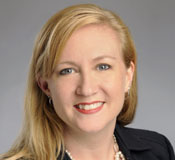 |
 Briefs |
What do the UHC rankings really mean?
 |
| Bill Bornstein called it a BHAG: In 2006, Emory Healthcare set its sights on being in the top 10% of UHC hospitals for quality and exceeded that mark in 2011. |
By now, most have heard the news: Emory University Hospital (EUH) and Emory University Hospital Midtown (EUHM) were ranked No. 2 and 3, respectively, on the 2013 Quality and Accountability Scorecard by the University HealthSystem Consortium (UHC), an alliance of 120 academic medical centers and 300 of their affiliated hospitals.
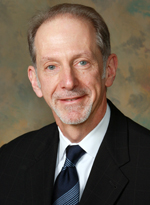 |
|
| Bill Bornstein |
Some may wonder: How does this particular ranking stand out from the crowd? After all, rankings are ubiquitous these days, and hospitals on every corner seem to have a banner about one of them.
According to Bill Bornstein, chief quality and medical officer in Emory Healthcare (EHC), doing well on the UHC rankings requires excellence in both the mundane and the sublime—the routine processes and procedures that can maximize safety and good outcomes and minimize morbidity and mortality as well as the extraordinary diagnostic and therapeutic challenges faced by academic medical centers treating the sickest patients in America.
UHC rankings are a relatively recent phenomenon and are gaining increasing relevance and attention. Only full academic hospitals are eligible to participate, although UHC is working to develop scorecards for affiliate hospitals as well.
In the past, says Bornstein, academic medicine defined its quality of care based primarily on different standards. "Ten years ago we didn't actually measure much of what we currently define as quality. To us then, 'quality' meant having high levels of NIH research funding and performing innovative, high-tech procedures other local hospitals couldn't do." By those standards, Emory ranked high.
What was missing though, was an understanding of how well we were doing in what Bornstein calls the "blocking and tackling" of health care. "We needed to be good at both the brilliant stuff and the routine."
In 2005, UHC came out with a composite score card for measuring quality and accountability in overall care. "We looked at different scoring systems and thought the UHC one was the most accurate reflection of overall care," says Bornstein.
What quickly became apparent though was that using these standards would be an exercise in humility: "At that point, he says, "we ranked in the bottom half of all UHC facilities."
In 2006 EHC set what Bornstein calls the "big, hairy, audacious goal" of being in the top 10%. (EUH exceeded this goal in 2011, ranking in the top 10, with EUHM only one place behind; both hospitals reached top 10 in 2012 and again now in 2013. Emory Healthcare is the only system ever to have all of its eligible hospitals simultaneously in the top 10. See other hospitals in the 2013 top 10 UHC list.)
Steps toward this goal included creating the EHC Office of Quality and the EHC Quality Academy, adopting the EHC "care transformation model," a cultural framework emphasizing patient- and family-centered care, transparency and disclosure, fair and just culture, cultural competency and diversity, shared decision-making, and a behavioral pledge among co-workers. Non-punitive systems were implemented to learn from errors, in recognition that the vast majority are due to system rather than individual shortcomings.
"One measure of validity of a quality scorecard is to ask whether the health system thought it was a good measurement system when it wasn't performing well on that scorecard," says Bornstein. "Everyone likes to get something in the mail that says, 'you've won.' However, what is really validating is to pick a scorecard as the best when it doesn't rank you well. Most important, when we set this goal in 2006, our Board Quality Committee asked us: Will the patients we care for be better off if we're ranked in the top 10%? When we said yes, unequivocally, they challenged us to go for it, and with their support, we did.
"These days," he adds, "all academic medical centers are paying attention to UHC scores. What that means is that we are all getting better at providing safer, more effective care, and that is a good thing for all our patients. We've gotten better faster than the others, which is even better news for our patients."
See related article on EHC's 2013 Quality Conference in which care teams shared results about the effectiveness of processes they have devised and implemented to improve quality.
 |
The little blue bird, otherwise known as the Twitter logo, has landed on the desks of various faculty members throughout health sciences as increasing numbers embrace the bird's ability to carry what they want to say in 140 characters or less.
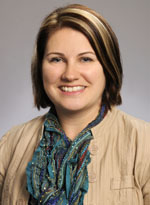 |
|
| Carolyn Clevenger | |
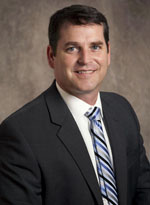 |
|
| Gary Miller | |
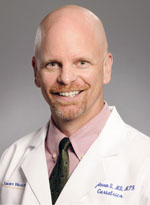 |
|
| Ted Johnson |
Nursing faculty member Carolyn Clevenger started tweeting four years ago after a few of her students sent her "friend" requests via Facebook. Wanting to keep her work and personal lives separate, she earmarked her Facebook page as personal and started a Twitter feed, @ccleven, for all things work-related.
Her tweeting has reaped benefits. Nurses have approached her at national meetings, having "met" her through her Twitter feed. When she promotes one of her published papers via Twitter, she does it mid-morning because a fellow academic found that time to be optimal for gaining followers (Clevenger is up to 268). She's an official tweeter for the American Geriatrics Society, and she follows the feeds of organizations such as Aging Services for Older Adults, the Mayo Clinic, and the White House. In return, they catch her tweets and retweet them.
"Tweeting is a great way for students to see what faculty are doing when they are not standing in front of them lecturing," Clevenger says. "They get to see what goes on outside the classroom."
Gary Miller, associate dean for research in the Rollins School of Public Health, started tweeting about all things exposome, @exposome, to drive traffic to his new exposome center's website. He tweets about once a week and hopes to grow his number of followers (currently 45) as the exposome center makes grants to researchers. "You break down geographic barriers in the Twittersphere," he says. "Intertwining a website and Twitter feed helps connect all the dots."
Ted Johnson, director of the division of general medicine and geriatrics and interim director for hospital medicine in the medical school, started tweeting after watching his teenaged daughters do so. He liked that he could broadcast quickly and concisely, so he could share news with his colleagues and vice versa. He chose the moniker "@baldheadted" after earning the nickname from his daughter's soccer team. Like other Twitter users, he frequently adds a subject tag (#CDCGrandRounds, for example) for those searching for information on a given topic.
Johnson tweets from national meetings so his colleagues at home can hear new advances as he does and from the clinic on challenging cases. His daughters roll their eyes about the single-mindedness of his subject matter and usually follow their texts to him with a tweet joke, such as "love you dad #geriatrics." In fairness, he does branch out on occasion, broadcasting his opinion in February 2012, for example, about the Super Bowl half-time show: "I thought Madonna rocked! Shaq and AARP agree." —Kay Torrance
New anti-cancer drugs are rooted in Emory research
 |
A recent New York Times story explores the potential of a new class of anticancer drugs that has its roots at Emory. The drugs break through "shields" built by cancers to ward off the threat posed by the patient's immune system. Many of the drugs are based on blocking PD-1, an immune-regulatory molecule whose importance in chronic infections was first described by Emory's Rafi Ahmed, director of the Emory Vaccine Center.
Of course, not every cancer research development described as transformative lives up to the hype. But clinical trial results, reported in the New England Journal of Medicine, are solid enough that researchers in the NYT article say they think they are seeing "a moment in medical history when everything changed." (Winship Cancer Institute's John Kauh was a co-author on one of the 2012 NEJM papers.)
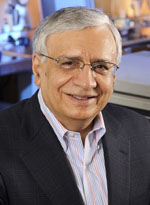 |
|
| Rafi Ahmed |
But what does Ahmed's work have to do with the new class of cancer drugs? Ahmed himself didn't set out to study cancer. For the past two decades, he and his colleagues have been studying T cells, parts of the immune system that are critical for responding to infections. Along the way, his lab made a series of discoveries concerning immune exhaustion, when the immune system, specifically T cells, are worn out after fighting a chronic infection or a tumor.
His team wanted to know what happened to T cells that have become worn out by chronic infection. Did they wither away and disappear from the body, or did they stick around?
His team found that some specific exhausted T cells indeed remained alive in the body after chronic infection but they no longer deployed their lethal weapons. These inactive T cells, unlike fresh T cells, had high levels of PD-1, which seems to be one means by which the immune system slows itself down so that its damaging attacks don't go on indefinitely.
Ahmed and his colleagues were the first to demonstrate PD-1's importance for regulation of the immune system.
Ahmed soon had hints that his discoveries would be relevant for cancer. After one of the first talks he gave describing exhausted T cells, several oncologists reported they had observed tumor-infiltrating T cells that were similarly present, but inactive. Scientists studying cancer then observed that the molecule that triggers PD-1 appears on many tumors. They reasoned that PD-1 could be one way a tumor disables the body's immune responses. Knowing that the T cells were still there, but only sleeping, made the possibility of reviving them seem achievable.
Ahmed says that the efficacy of PD-1 drugs could be further increased by combining them with other drugs that unlock the immune system. Several research teams around the world are now examining which tumors are most vulnerable to PD-1-based immunotherapy.
—Quinn Eastman (from a recent post on the Emory's Health Sciences Research blog, Lab Land)
Strengthening research at Winship
Strengthening Winship's research programs and footprint in the cancer world is the name of the game for Kimberly Kerstann. As associate director for cancer research administration at Winship Cancer Institute, her job is to help Winship stay at the forefront in cancer research while finding ways to increase research efficiency and effectiveness.
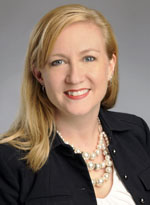 |
|
| Kimberly Kerstann |
Kerstann, an Emory-trained geneticist and molecular biologist and former National Cancer Institute (NCI) post-doc in cancer epidemiology and genetics, arrived at Winship in 2009, just before it received designation as Georgia's only NCI-designated center. Her main task then as director of research projects was to incorporate genetic testing into Winship's clinical trials.
In 2010, Winship Executive Director Wally Curran asked her to take on administrative oversight for research operations across Winship. At the time, Winship was gearing up to apply for renewal of its NCI grant, which required a 1,000-page submission detailing the history and accomplishments of Winship's four research programs, in cancer cell biology, cancer prevention and control, cancer genetics and epigenetics, and discovery and developmental therapeutics.
Kerstann's role in helping compile this submission, which received an "outstanding" score and led to renewal of Winship's NCI grant, gave her important insight into Winship's research infrastructure and how to implement best practices going forward in research administration.
In 2016, Winship will submit another renewal, along with a request to be considered as an NCI Comprehensive Cancer Center. To begin this renewal process, Kerstann helped set up the framework for a database to track needed information automatically and hired a new IT director last year to manage the system. The system will link initial pilot grants to their subsequent federal grants to show perpetual progression of individual studies. She has spent a lot of time meeting with Curran and other Winship leaders who manage specific programs, keeping everyone on deadline and helping ensure that proposals are consistent with Winship's strategic plan and that all the numbers in them add up.
In the meantime, Kerstann also is working on stretching Winship's dollars and finding savings wherever she can. She has worked with the medical school's Trish Haugaard, assistant dean in research administration, over the past two years, for example, to consolidate Winship's cancer genomics program with the medical school-managed genomics core, to create the Emory Integrated Genomics Core.
The fun in her role, Kerstann says, is to be involved in the big picture and high-level strategic planning going on at Winship—and then help Winship scientists implement the plan. The challenge? "We are hitting that point in our growth when we want to accomplish so much, but funds are tight. That means being more creative."
Ensuring that our interests are represented in Georgia and Washington
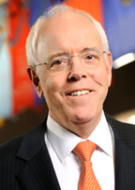 |
|
| Wright Caughman |
Last month our nation faced an experience that was disappointing to some and disheartening to all—the shutdown of the federal government. As deeply disconcerting as this period was, the way the faculty and staff of the Woodruff Health Sciences Center (WHSC) responded to it was a source of great pride. Our leadership, our government and community affairs experts, our communications team, and others worked closely to keep us current on the rapidly developing situation and help us understand the potential impact to our institution. A breakdown in the machinery of our government brought to light the inherent strength in the machinery of the WHSC, and I’m grateful to all who worked daily to keep us informed and prepared.
This experience was just part of a pattern of collaborative, collegial response to a challenging external environment that is characteristic of the WHSC, the broader university, and our peer academic health sciences centers nationwide. We face the ongoing sequester and the fight to protect budgets for education, research, and health care, but we are working together to make our voices heard as difficult decisions are made at the local, state, and national levels.
The sequester has impacted and will continue to impact us profoundly. We have lost millions in funding, and we stand to lose tens of millions more in the tough times ahead. Our ability to fulfill our lifesaving and life-affirming missions depends on our being part of the solution. That's why leaders from across the university, along with our peer institutions, are advocating at the State House and on Capitol Hill for a "big fix" to the problem of sequestration and budget cuts—one that includes sustained federal investments in all three elements of our tripartite mission. Absent a grand bargain, we also support incremental steps that bring relief to our nation's fiscal challenge in a fair and balanced way that takes into account the extraordinary significance of our missions.
President Wagner and I, along with several others, have written the Georgia Congressional delegation, and we routinely visit Washington, DC, to make sure that the interests of academic health sciences centers are not overlooked. Institutions like ours are centers of innovation, education for the next generation of health care providers, and the most complex medical care in the nation, and we are working together to ensure that our interests are well represented in the ultimate solution to the budget crisis.
My deepest thanks go out to Charlie Harman, Cameron Taylor, and our tireless government and community affairs and communications teams for helping us maintain a constant drumbeat with our elected officials.
Please direct questions and comments to evphafeedback@emory.edu.
 |
RSPH receives PCORI award to improve outcomes research
 |
Researchers at the Rollins School of Public Health received an award from the Patient-Centered Outcomes Research Institute (PCORI) to help advance patient-centered, comparative effectiveness research. Qi Long, (Biostatistics and Bioinformatics) will lead the project, which will focus on the development, dissemination, and assessment of methods to account for missing data in large observational studies. Read more.
Nursing school grants
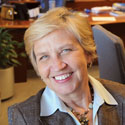 |
|
| Linda McCauley |
The Nell Hodgson Woodruff School of Nursing received a $6.5 million grant from the Helene Fuld Health Trust to establish a palliative care fellowship program. The grant will provide program support and scholarships to select nursing students each year to become immersed in palliative care initiatives, research, and policy development by working with the Emory Palliative Care Center, beginning in summer 2014, says Dean Linda McCauley. Read more.
The nursing school and Georgia Perimeter College received a $900,000 grant from the NIH's Bridges to the Baccalaureate Program to increase the pool of under-represented students prepared for careers in research. Students admitted to Perimeter College will be part of an eight-week summer immersion program focused on rigorous nursing education and exposure to academic research. After completing their associate's degree, they will transition into the BSN program at Emory. Read more.
Yerkes receives grant to study genomics of HIV infection
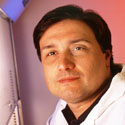 |
|
| Guido Silvestri |
Yerkes National Primate Research Center received a four-year, $3.3 million grant from the NIH to study HIV infection at the level of the genome. "Our study will measure thousands of genes that are turned off and on in patients and animals that get disease and in people receiving HIV medication and compare them with African species of monkeys that are AIDS-resistant," says Guido Silvestri, Yerkes division chief of microbiology and immunology, who is leading the research team. Read more.
Del Rio elected to IOM
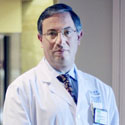 |
|
| Carlos del Rio |
Carlos del Rio, chair of the Hubert Department of Global Health at Rollins School of Public Health (RSPH), Hubert Professor, and professor of medicine as well, was elected as a member of the Institute of Medicine. He is director of the Emory AIDS International Training and Research Program and co-director of the Emory Center for AIDS Research. His research, funded by the CDC and the NIH, focuses on decreasing barriers to care among HIV-infected persons, particularly among racial and ethnic minorities and other underserved populations, such as substance abusers. He also works to improve access to antiretroviral therapy for HIV patients and build human research capacity in countries and communities with limited resources. Read more.
2013 EHC Quality Conference
Each year, care teams in Emory Healthcare report on measures they have implemented to improve effectiveness of care and/or maximize safety and quality. This year's quality conference featured posters on more than 20 such projects, with top recognition awarded to four. Jennifer Zreloff, Monica Agrawal, Jason Higdon, and Regina Martin, made up one of four top teams recognized for their project, Improving Blood Pressure Control at Emory Patient-Centered Primary Care (PCPC).
One-third of the PCPC clinic's patients have high blood pressure, but the team found that only 63% of these patients met their target for control (<140/90). So the team came up with a plan to reach out to these 850 patients. The plan included offering free nurse visits to titrate their blood pressure medicines, mailing reminders to get their blood pressure checked (and get their flu vaccine), and enrolling them in group nutrition sessions. In the end, the team was able to raise the number of patients reaching their target blood pressure from from 63% to 76%. Next year, the clinic plans to work on the issue of obesity.
Emory's 1% Club
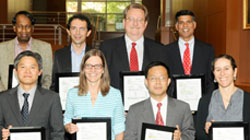 |
| Front, L to R: Hanjoong Jo, Karen Levy, Baowei Fei, Anice Lowen. Back: Ajit Yoganathan, Mirko Paiardini, Richard Cummings, Viraj Master. Not pictured: Vincent Marconi. |
The medical school recently recognized faculty whose NIH proposals have been ranked in the top 1% by NIH reviewers as members of the new Emory 1% Club. "When you submit a proposal to the NIH, a committee reviews it and ranks it with a percentage," explains Trish Haugaard, the medical school's assistant dean for research. "Being ranked 1% is essentially like getting a perfect score."
New leadership development program launches
The Office of Business Practice Improvement is launching the Business Practice Improvement Scholars program. The program is designed to help early- to mid-career Emory staff members develop problem-solving and leadership skills and also requires them to identify and solve a problem within their home unit. Applications for the January class are due Nov. 30. More info.
Crisis drill on campus
 |
Emory, the CDC, and DeKalb County emergency services, among others, recently held a crisis drill on the Emory Campus. The scenario, led by Emory's Office for Critical Event Preparedness and Response, was a simulated train derailment.
Center for Injury Control commemorates 20th year
The Center for Injury Control, a multi-institutional consortium aimed at stopping violent assaults and unintentional injuries and developing the next generation of injury prevention professionals, was formed 20 years ago. Read more and watch a video highlighting what the center does.
Notable
Mohammed Ali (global health and epidemiology, Rollins School of Public Health) was one of four recipients of the 2013 Pfizer Faculty Awards presented by the Association of Schools and Programs of Public Health.
Peter Brown (RSPH) will receive Emory's Marion V. Creekmore Internationalization Award. Brown helped establish the Emory Global Health Institute and created a minor in global health, culture, and society.
Elizabeth Corwin, Kristy Martyn, and Judith Wold were named fellows of the American Academy of Nursing. Emory now has 22 AAN fellows.
Alan Gordon joins Emory as director of the Division of Gynecologic Oncology. He previously served at Mercer University School of Medicine.
William Hutton, Zili Wang, and Tim Yoon (orthopaedics) received the Lumbar Spine Research Prize awarded by the International Society for the Study of the Lumbar Spine.
Ted Johnson (medicine) was named the Paul W. Seavey Chair in Internal Medicine.
Terri McFadden (pediatrics) was named a member of the Georgia Board for Physician Workforce.
Walt Orenstein (medicine) was recognized for his book, Vaccines, in the public health category by the British Medical Association.
Steve Warren (human genetics) received the Association for Molecular Pathology's Award for Excellence in Molecular Diagnostics.
